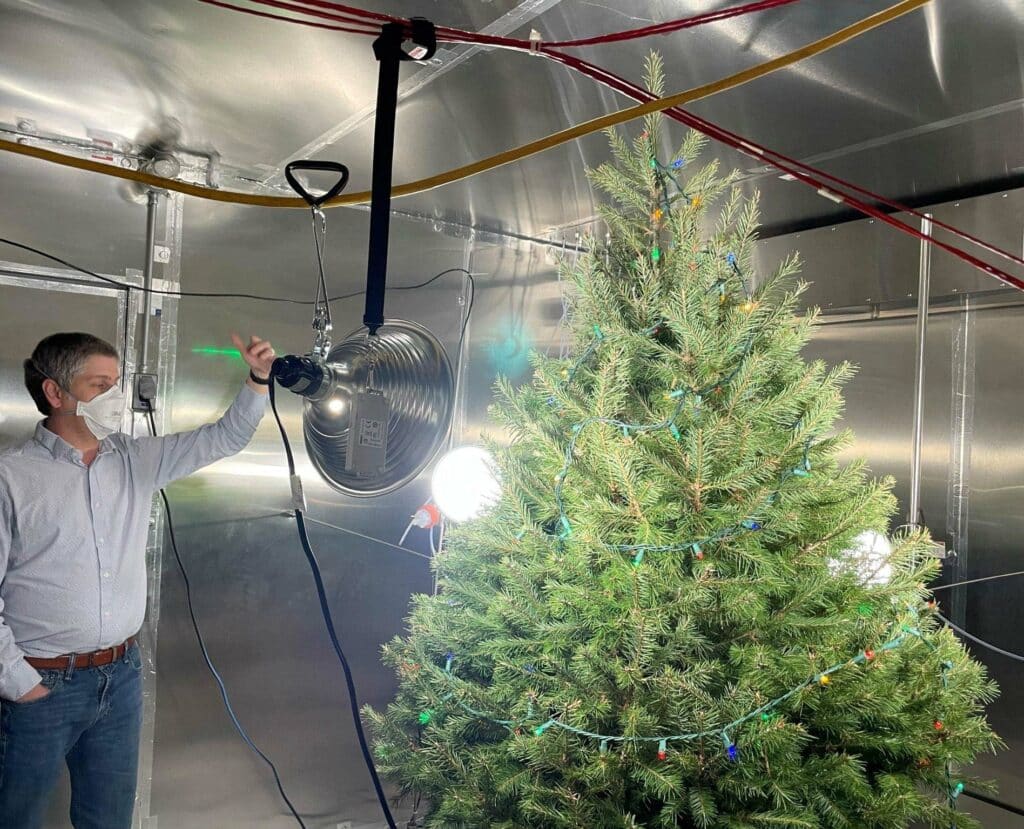Every year, between 25 and 30 million live Christmas trees are sold in the U.S. Surprisingly, the emissions of volatile organic compounds (VOCs) from these trees indoors have yet to be studied, as far as we know.
There’s a significant gap in our understanding of how volatile organic compound (VOC) emissions change when a typical Christmas tree is cut down and brought indoors.
It is known that these trees emit something, and the question is: How big of a source is it? Scientists wanted to explore which chemicals are cast and how much and to put that into the context of other sources of chemicals in a house.
To address these questions, scientists at NIST used a common Christmas tree, a Douglas fir, in a chamber. Over 17 days, they measured the quantity and types of volatile organic compounds (VOCs) it released. Additionally, they explored whether these VOCs reacted with other indoor air components, forming new combinations.

The familiar, fresh scent linked with Christmas trees comes from volatile organic compounds (VOCs) known as monoterpenes. These compounds are also present in air fresheners, candles, and personal care products.
Outdoors and conifers, including most Christmas trees, release monoterpenes, impacting outdoor air quality. However, there’s limited knowledge about the amount of monoterpenes released when a tree is cut down and brought indoors.
Studies indicate that monoterpenes can react with ozone. While ozone in the upper atmosphere acts as a protective layer against the Sun, at ground level, it’s formed through chemical reactions with light and can cause symptoms like coughing and throat irritation. Ozone also readily reacts with other airborne chemicals, forming new compounds.
The scientists were curious about the impact of ozone in the presence of an indoor tree, so they placed it in a controlled chamber. Using proton-transfer-reaction mass spectrometry (PTR-MS), a method for detecting airborne organic compounds, they measured the emitted volatile organic compounds (VOCs) over 17 days.
In their experiment, the scientists recreated a home environment. They adorned the tree with typical holiday lights, exposed it to a simulated day-night cycle with bright lights, turned off the lights every 12 hours, and watered the tree daily. They introduced outside air at a rate commonly found in households and continuously monitored the chemicals in the indoor air.
Monoterpenes were the most abundant volatile organic compounds (VOCs) emitted from the tree. Their concentration peaked on the first day and significantly decreased by the third day. Initially, the concentration was comparable to a plug-in air freshener or a newly constructed house before dropping by almost ten times its original amount. The researchers identified 52 distinct types of monoterpenes.
Upon introducing ozone into the chamber, the scientists observed its reaction with monoterpenes, leading to byproducts such as formaldehyde, another type of VOC, and other reactive chemicals. The concentration of monoterpenes decreased further with the addition of ozone, while formaldehyde levels increased, impacting indoor air chemistry. However, the formaldehyde produced was relatively small, around 1 part per billion. Typical U.S. houses have formaldehyde concentrations ranging from 20 to 30 parts per billion.
Dustin Poppendieck, an environmental engineer at the National Institute of Standards and Technology (NIST) said, “For people sensitive to VOCs, Christmas trees could be one possible cause for watery eyes and noses, especially when initially brought indoors. In that case, opening a window near the tree will reduce exposure. In addition, newly cut trees can be left outdoors or in a garage for three days before bringing them into the home as the emission strength naturally decays over time.”
Journal Reference:
- Dustin Poppendieck, Rileigh Robertson, and Michael Link. Jingle Bells, What Are Those Smells? Indoor VOC Emissions from a Live Christmas Tree. Indoor Environments. Published online Dec. 22, 2023. DOI: 10.1016/j.indenv.2023.100002
